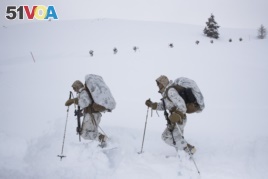24 February, 2019
Hiding behind a wall of snow, two American Marines melt some snow to make drinking water. They are spending the night digging out a defensive position high up in the Sierra Nevada mountains of California.
The Marines keep their map of targets protected in clear plastic on the icy surface below the machine gun. Other Marines just a few kilometers away are preparing to attack.
They are about 2,440 meters above sea level. The air is thin, the snow is high and the temperature is low and dropping further. The mountain weather is similar to that in parts of Russia, North Korea and China, countries where the U.S. believes troops could fight the next war.
Major General William F. Mullen is head of the Marines' Training and Education Command. He told the Associated Press, "We haven't had to deal with these things. We've been very focused on Iraq and Afghanistan."
Mullen added, "What we really have to do is wake folks up, expose them to things that they haven't had to think about for quite a while."

A group of U.S. Marines walk along a snow-covered trail during advanced cold-weather training at the Marine Corps Mountain Warfare Training Center Sunday, Feb. 10, 2019, in Bridgeport, Calif. (AP Photo/Jae C. Hong)
The U.S. has been fighting for 17 years against the Taliban and al-Qaida-linked forces. Now the country's military is preparing for possible conflicts in Russia, China, North Korea and Iran.
U.S. forces are training to survive severely cold weather and fight a high-tech battle of drones, electronic and cyber weapons.
Colonel Kevin Hutchison is the training center commander. He said "What you're seeing here is Marines fighting Marines, so we are replicating a near-peer threat" in the training exercise.
As a snowstorm blows around them, Mullen and Hutchison move through the woods to check in with the group of 250 Marines on the mountain. Their training goal is to prevent 800 attackers from gaining control of nearby Wolf Creek Bridge.
Marine Reese Nichols is from Pensacola, Florida. Another, Chase Soltis, calls Bozeman, Montana home. They had dug their defensive position a day earlier. The two have been watching all night for enemy movement while melting snow for drinking water.
Nichols says the hardest part is "boiling water 24/7. And the cold. It's cold."
The Marines use snowshoes and cross-country skis to get around. They wrap their weapons in white to make it hard for the enemy to see. It is a struggle to keep ammunition dry and heavy machine guns from sinking into the snow.
Marine Rian Lusk is one of the trainers. He says many of the troops have never dealt with snow before. And, the troops have to be digging or moving up the mountain all the time. Lusk says "It's physically taxing, but more than anything, I think, it's mentally taxing."
Military changes its training
A very different training exercise is happening about 640 kilometers to the south at Twentynine Palms Marine base.
Trainers here provide the Marines with only the general purpose of the exercises. The trainees make their own battle plans as they would in a real conflict.
Commanders say today's troops have to be more independent, providing their own protection and support. The training, Mullen said, is to prepare Marines to remain unseen and make quick changes to their battle plan when faced with unexpected threats.
Back on the mountain, the attacking force saw a defensive position and opened fire. Real ammunition is not used so no one gets hurt. But the competition is real.
Hutchinson told the leader of the defensive force, "You took casualties today, and you didn't respond to it." Mullen asked the leader why he did not move his Marines to a safer place.
The group's leader, Brendan Dixon, defended his decision. He said his forces were in the right place to defend the bridge.
It turns out, he was right.
Moving toward the bridge, the attacking forces became trapped, and open to enemy fire. They were unable to move through a narrow area filled with snow.
After the battle, Marine trainers judged that the attackers suffered 30-40 percent casualties, while Dixon's defensive troops had about 10 percent.
The attacking force, said Hutchison, made some decisions that would have resulted in Marine deaths in a real battle. He added, it is better to learn now than in conflict.
I'm Caty Weaver. And I'm Bryan Lynn.
The Associated Press reported this story. Hai Do adapted it for VOA Learning English. Caty Weaver was the editor.
Write to us in the Comments Section or on 51VOA.COM.
________________________________________________________________
Words in This Story
focus - n. to direct attention or effort at something specific
expose - v. to cause (someone) to experience something or to be influenced or affected by something
replicate - v. to repeat or copy (something) exactly
peer - n. a person who belongs to the same age group or social group as someone else
folks - n. people in general (informal)
casualty - n. a person who is hurt or killed during an accident, war, etc.
respond - v. to do something as a reaction to something that has happened or been done